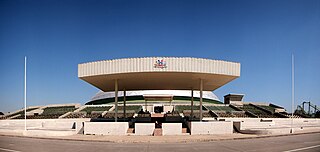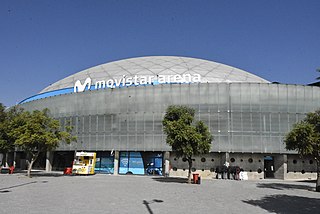Related Research Articles

Santiago, also known as Santiago de Chile, is the capital and largest city of Chile and one of the largest cities in the Americas. It is located in the country's central valley and is the center of the Santiago Metropolitan Region, which has a population of seven million, representing 40% of Chile's total population. Most of the city is situated between 500–650 m (1,640–2,133 ft) above sea level.

Televisión Nacional de Chile (TVN) is a Chilean public service broadcaster. It was founded by order of President Eduardo Frei Montalva and it was launched nationwide on 18 September 1969. Since then, the company has been reorganized on several occasions and its operations areas have increased over the years, becoming one of the leading television broadcasters in Chile and South America. Law 17 377 of 1970 established that TVN must be a public, autonomous, pluralistic, and representative public service. TVN's public mission determines the obligation to promote the national cultural identity, the values of democracy, human rights, care for the environment and respect for diversity. Furthermore, Televisión Nacional governs the programming of its services according to criteria established by the National Television Council (CNTV).

The Santiago General Cemetery in Santiago, Chile, is one of the largest cemeteries in Latin America with an estimated two million burials. The cemetery was established in 1821 after Chile's independence when Bernardo O'Higgins inaugurated the Alameda de las Delicias along the old course of the Mapocho River. O'Higgins set aside more than 85 hectares of land for the foundation of what became a magnificent grounds filled with ornate mausoleums surrounded by palm and leaf trees set amidst lush gardens and numerous sculptures, which have been estimated be 237. The cemetery, which is located northwest of Cerro Blanco, serves as a true urban park for Santiago located in the municipality of Recoleta.

Estadio El Teniente, also known as Estadio El Teniente-Codelco for sponsorship reasons, is a multi-purpose stadium in Rancagua, Chile. It is currently used mostly for football matches. The stadium can fit 14,087 people and was built in 1945 with the name Braden Copper Company Stadium (Estadio Braden Copper Co.). The stadium is home to football club O'Higgins, which is based in Rancagua.

O'Higgins Park, covering approximately 75 hectares, is Santiago, Chile's second largest public park after Metropolitan Park. It is situated in the center of the capital city, within the Santiago Commune.

O'Higgins Fútbol Club, also known as O'Higgins de Rancagua, is a Chilean professional football club based in Rancagua, that currently plays in the Campeonato Nacional. The club's home stadium is Estadio El Teniente, opened in 1945 and renovated for the 2015 Copa América, which was hosted by Chile.

Movistar Arena is a 17,000-seat multi-purpose indoor arena in Santiago, Chile. It is located inside O'Higgins Park, in downtown Santiago. Its main structure was built in 1956, but it remained unfinished and without a roof, until the roof was installed in 2000.

Carolina Montserrat Tohá Morales is a Chilean political scientist, educator, and politician currently serving as Chile's Minister of the Interior and Public Security since 6 September 2022, during the administration of President Gabriel Boric. Tohá previously served as Minister Secretary General of Government in the administration of President Michelle Bachelet from March to December 2009, becoming the first woman to hold this position.

Puente Alto is a city and commune of Chile. It is the capital of the Cordillera Province in the Santiago Metropolitan Region. Located at the south of the Great Santiago conurbation, it houses 568,106 inhabitants, making it the most populous commune in Chile.

The Fiestas Patrias of Chile consist of two days, with a third one added on some years:

Paine is a Chilean city, forming part of Greater Santiago, and a commune in the Maipo Province, Santiago Metropolitan Region.

The Chilean Articles of Confederation is a document declaring the independence of Chile from the Spanish Empire. It was drafted in January 1818 and approved by Supreme Director Bernardo O'Higgins on 12 February 1818 at Talca, despite being dated in Concepción on 1 January 1818. The ceremony of independence was performed on 12 February 1818, the first anniversary of the Battle of Chacabuco.

Agustín Ross Cultural Centre, previously known as Casino Ross, is the cultural center of the city of Pichilemu in Libertador General Bernardo O'Higgins Region, Chile. It was constructed between 1906 and 1909 at the request of politician Agustín Ross Edwards. The structure of the cultural center is very similar to that of the Grand Trianon in Versailles, France.

Colegio de la Preciosa Sangre de Pichilemu, often shortened to Preciosa Sangre, is a coeducational Roman Catholic private state-subsidized day school, serving students in preschool through twelfth grade, located in the commune of Pichilemu, Libertador General Bernardo O'Higgins Region, Chile.

The history of Pichilemu began around the 16th century, when Promaucaes inhabited the modern Pichilemu region. According to Chilean historiographer José Toribio Medina on his book Los Restos Indígenas de Pichilemu (1908), Spanish conqueror Pedro de Valdivia gave Topocalma encomienda, in which Pichilemu was supposed to be, to Juan Gómez de Almagro, on January 24, 1544.

The 2010 Pichilemu earthquakes, also known as the Libertador O'Higgins earthquakes, were a pair of intraplate earthquakes measuring 6.9 and 7.0 Mw that struck Chile's O'Higgins Region on 11 March 2010 about 16 minutes apart. The earthquakes were centred 15 kilometres (9.3 mi) northwest of the city of Pichilemu.

Fondas, also known as ramadas or chinganas, are temporary establishments in Chile that emerge during the Fiestas Patrias, a national celebration held in September. These venues offer a wide array of food and beverages to the public. One of the most renowned fondas is La Grandiosa Bertita, situated in O'Higgins Park, Santiago, Chile.

René Gabriel Maturana Maldonado was a Chilean journalist and the 36th Mayor of Pichilemu, holding the position from his appointment by President Augusto Pinochet Ugarte on 31 August 1984 until his resignation in April 1992.

Santiago Metro Line 1 is the oldest of the seven existing rapid transit lines that make up the Santiago Metro system. Being its busiest, it has a total of 27 stations along its 19.3 km (12.0 mi) length, constructed almost entirely underground, and is located primarily along the axis formed by the Avenida Libertador General Bernardo O'Higgins, Providencia Avenue and Apoquindo Avenue.

Pichilemu, originally known as Pichilemo, is a beach resort city and commune in central Chile, and capital of Cardenal Caro Province in the O'Higgins Region. The commune comprises an urban centre and twenty-two villages, including Ciruelos, Cáhuil, and Cardonal de Panilonco. It is located southwest of Santiago. Pichilemu had over 13,000 residents as of 2012.
References
- ↑ "Consulta Noticias". Archived from the original on 28 September 2007. Retrieved 15 September 2007.
- ↑ "La Cuarta". Archived from the original on 28 September 2007. Retrieved 15 September 2007.
- ↑ El Líder de San Antonio